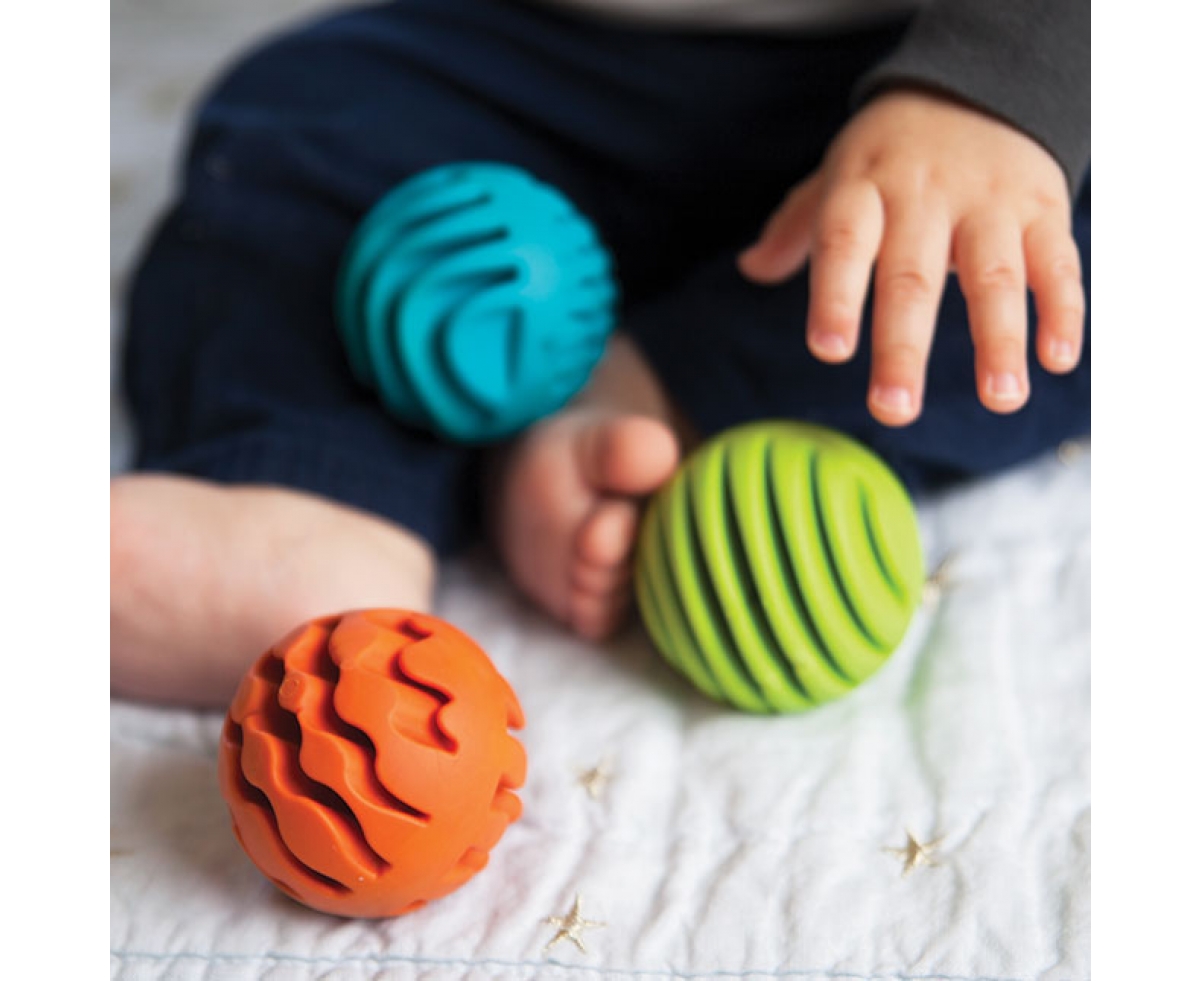Pressure or proprioceptive information: heavy toys
Author: Els Rengenhart
Occupational therapist and SI specialist
The importance of pressure or proprioceptive information in combination with heavy toys

At the request of Tanja from Toys42hands I tried out the Sensory Rollers from Fat Brain Toys.
Properties
Three colored balls of 6 cm diameter . The balls are relatively heavy - about 150 grams each. This makes them comfortable to hold for adults as well. The balls are made of silicone - PBA free. This makes them bite-resistant for babies and small children. They can also be put in the dishwasher. Each ball has two different types of relief . When picking up, rolling or moving the balls in any way, they make a soft, pleasant sound . The manufacturer states that they are suitable for children from 6 months to five years. I think that these beautifully and thoughtfully designed balls can also be used by older children and even adults .
The sensory balls can be used for various purposes:
• Playing and moving on the ground.
For babies and young children to roll with, pick up, put in their mouth and make sounds with. Both by their shape and the sound they make, they entice to move along. Because the sensory balls are relatively heavy and possibly also by the material and the relief of the balls, they do not roll far away immediately. This entices them to crawl back to them and continue playing. In this way they also entice to play and move over the ground.

• The balls are comfortable to hold, especially because of their weight.
This is certainly true for adults and older children . Because of the round shape, you will almost automatically move them between both hands. In this way, they provide just the right amount of pressure. This is a pleasant feeling that can help you to be less distracted if you want to think about something in a focused way or, for example, have to pay attention at school or in a meeting. It is then a kind of wall or protection against other distractions. If you want to know more about this, see Concentration
• Musical instrument
Because of the different sounds the sensory balls make, they can also be used as a musical instrument. For example, by shaking the balls or quickly rolling them from one hand to the other.
• No more sound when pressed
The funny thing about these sensory balls is that if you put enough pressure on them, for example by rolling a ball with pressure over your thigh or over a table, they no longer make a sound. Of course, you can also think of all kinds of games with them, such as rolling a ball over a table for as long as possible without making a sound.
• Relief feeling games
The six different types of reliefs also allow you to feel all sorts of things on the sensory balls. You can also make a game out of that. For example, by putting a ball in a pillowcase, and after the child has felt the ball without looking, pointing to that ball on the box provided.
The importance of pressure or proprioceptive information
Posture and movement
Pressure provides information about the posture and movements of our body. This allows us to control our body and movements without paying much attention to it; our movements are therefore largely automatic.
Verstibular and tactile hyper- and hyposensitivity
Pressure also plays an important role in normalizing vestibular and tactile hypersensitivity and hyposensitivity. See also Primitive Reflexes. By using pressure in combination with touch and movement, the touch and movement stimuli can be processed better.
Stabilizing effect on sensory stimuli
Pressure has a stabilizing effect on sensory stimuli in general, and touch and movement stimuli in particular. It mainly counteracts the rapid change of over- and under-sensitivity reactions.
Information for the senses
Pressure is a primarily information-oriented sense, unlike, for example, touch and balance. These last two senses also have a strong warning function in relation to maintaining stability and balance. The balance organ mainly pays attention to not falling and our touch that the ground is firm enough to support ourselves and move on. When the warning functions of the senses predominate, we mainly show survival behavior - an adequate reaction in situations of danger. When the informational functions of the senses predominate, we are more focused on experience.
It is my experience that using pressure or proprioceptive information can contribute to greater stability and experience.
This applies to everyone - with or without sensory processing problems.














Leave a comment